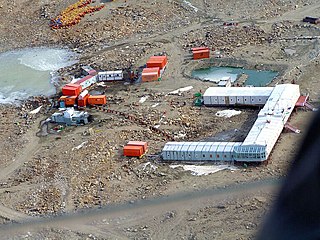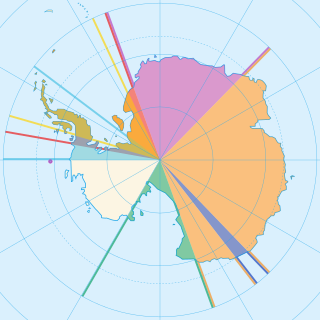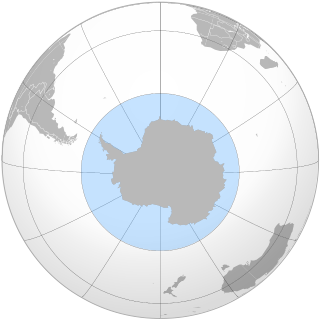
The Antarctic Treaty and related agreements, collectively known as the Antarctic Treaty System (ATS), regulate international relations with respect to Antarctica, Earth's only continent without a native human population. It was the first arms control agreement established during the Cold War, setting aside the continent as a scientific preserve, establishing freedom of scientific investigation, and banning military activity; for the purposes of the treaty system, Antarctica is defined as all the land and ice shelves south of 60°S latitude. Since September 2004, the Antarctic Treaty Secretariat, which implements the treaty system, is headquartered in Buenos Aires, Argentina.

The Antarctic is a polar region around Earth's South Pole, opposite the Arctic region around the North Pole. The Antarctic comprises the continent of Antarctica, the Kerguelen Plateau and other island territories located on the Antarctic Plate or south of the Antarctic Convergence. The Antarctic region includes the ice shelves, waters, and all the island territories in the Southern Ocean situated south of the Antarctic Convergence, a zone approximately 32 to 48 km wide varying in latitude seasonally. The region covers some 20 percent of the Southern Hemisphere, of which 5.5 percent is the surface area of the Antarctica continent itself. All of the land and ice shelves south of 60°S latitude are administered under the Antarctic Treaty System. Biogeographically, the Antarctic realm is one of eight biogeographic realms of Earth's land surface.

The Ross Dependency is a region of Antarctica defined by a sector originating at the South Pole, passing along longitudes 160° east to 150° west, and terminating at latitude 60° south. It is claimed by New Zealand. Since the Antarctic Treaty came into force in 1961, Article IV of which states: "No acts or activities taking place while the present Treaty is in force shall constitute a basis for asserting, supporting or denying a claim to territorial sovereignty in Antarctica or create any rights of sovereignty in Antarctica", most countries do not recognise territorial claims in Antarctica.

Peter I Island is an uninhabited volcanic island in the Bellingshausen Sea, 450 kilometres (240 nmi) from continental Antarctica. It is claimed as a dependency of Norway and, along with Bouvet Island and Queen Maud Land, composes one of the three Norwegian dependent territories in the Antarctic and Subantarctic. The island measures approximately 11 by 19 kilometres, with an area of 156 km2 (60 sq mi); its highest point is the ultra-prominent, 1,640-metre-tall (5,380 ft) Lars Christensen Peak. Nearly all the island is covered by a glacier, and it is surrounded most of the year by pack ice, making it inaccessible during these times. There is little vertebrate animal life on the island apart from some seabirds and seals.

The British Antarctic Territory (BAT) is a sector of Antarctica claimed by the United Kingdom as one of its 14 British Overseas Territories, of which it is by far the largest by area. It comprises the region south of 60°S latitude and between longitudes 20°W and 80°W, forming a wedge shape that extends to the South Pole, overlapping the Antarctic claims of Argentina and Chile.

The Australian Antarctic Territory (AAT) is a part of East Antarctica administered by the Australian Antarctic Division, an agency of the federal Department of Agriculture, Water, and the Environment. The territory's history dates to a claim on Enderby Land made by the United Kingdom in 1841, which was subsequently expanded and eventually transferred to Australia in 1933. It is the largest territory of Antarctica claimed by any nation by area. In 1961, the Antarctic Treaty came into force. Article 4 deals with territorial claims, and although it does not renounce or diminish any pre-existing claims to sovereignty, it also does not prejudice the position of Contracting Parties in their recognition or non-recognition of territorial sovereignty. As a result, only four other countries—New Zealand, the United Kingdom, France, and Norway—recognise Australia's claim to sovereignty in Antarctica.

The Agreed Measures for the Conservation of Antarctic Fauna and Flora is a set of environmental protection measures which were accepted at the third Antarctic Treaty Consultative Meeting in Brussels in 1964. The Agreed Measures were formally in force as part of the Antarctic Treaty System from 1982 to 2011, when they were withdrawn as the principles were now entirely superseded by later agreements such as the 1991 Protocol on Environmental Protection to the Antarctic Treaty. The Agreed Measures were adopted in order to further international collaboration within the administration of the Antarctic Treaty System and promote the protection of natural Antarctic ecological systems while enabling scientific study and exploration.

This is a timeline of the history of New Zealand's involvement with Antarctica.

The Indian Antarctic Programme is a multi-disciplinary, multi-institutional programme under the control of the National Centre for Polar and Ocean Research, Ministry of Earth Sciences, Government of India. It was initiated in 1981 with the first Indian expedition to Antarctica. The programme gained global acceptance with India's signing of the Antarctic Treaty and subsequent construction of the Dakshin Gangotri Antarctic research base in 1983, superseded by the Maitri base from 1989. The newest base commissioned in 2012 is Bharati, constructed out of 134 shipping containers. Under the programme, atmospheric, biological, earth, chemical, and medical sciences are studied by India, which has carried out 30 scientific expeditions to the Antarctic as of 14 October 2010.

True South is the only flag of Antarctica formally recognized by members of the Antarctic Treaty System, the condominium that governs the continent. However, adoption of the flag is not yet universal, and dozens of unofficial designs have also been proposed.

The Antarctic Convergence or Antarctic Polar Front is a curve continuously encircling Antarctica, varying in latitude seasonally, where cold, northward-flowing Antarctic waters meet the relatively warmer waters of the sub-Antarctic. Antarctic waters predominantly sink beneath the warmer subantarctic waters, while associated zones of mixing and upwelling create a zone very high in marine productivity, especially for Antarctic krill.

The Antarctic Conservation Act, enacted in 1978 by the 95th United States Congress, and amended by Pub.L. 104–227 (text)(PDF), is a United States federal law that addresses the issue of environmental conservation on the continent of Antarctica. The Departments of the Treasury, Interior and Commerce are responsible for the Act's enforcement.

As Antarctica has never been permanently settled by humans there has historically been little military activity in the Antarctic. Because the Antarctic Treaty, which came into effect on June 23, 1961, bans military activity in Antarctica, military personnel and equipment may only be used for scientific research or any other peaceful purpose on the continent.

Seven sovereign states have made eight territorial claims in Antarctica, which are Argentina, Australia, Chile, France, New Zealand, Norway, and the United Kingdom. These countries have tended to place their Antarctic scientific observation and study facilities within their respective claimed territories; however, a number of such facilities are located outside of the area claimed by their respective countries of operation, and countries without claims such as India, Italy, Pakistan, Russia, Ukraine, and the United States have constructed research facilities within the areas claimed by other countries.

Antarctica is Earth's southernmost continent. It contains the geographic South Pole and is situated in the Antarctic region of the Southern Hemisphere, almost entirely south of the Antarctic Circle, and is surrounded by the Southern Ocean. At 14,200,000 square kilometres, it is the fifth-largest continent and nearly twice the size of Australia. It is by far the least populated continent, with around 5,000 people in the summer and around 1,000 in the winter. The vast majority of Antarctica is covered by ice that averages 1.9 km in thickness.

The Southern Ocean, also known as the Antarctic Ocean, comprises the southernmost waters of the World Ocean, generally taken to be south of 60° S latitude and encircling Antarctica. As such, it is regarded as the second-smallest of the five principal oceanic divisions: smaller than the Pacific, Atlantic, and Indian oceans but larger than the Arctic Ocean. Over the past 30 years, the Southern Ocean has been subject to rapid climate change, which has led to changes in the marine ecosystem.

Queen Maud Land is a roughly 2.7-million-square-kilometre (1.0-million-square-mile) region of Antarctica claimed by Norway as a dependent territory. It borders the claimed British Antarctic Territory 20° west and the Australian Antarctic Territory 45° east. In addition, a small unclaimed area from 1939 was annexed on 12 June 2015. Positioned in East Antarctica, it makes out about one-fifth of the continent, and is named after the Norwegian queen Maud of Wales (1869–1938).
While crime in Antarctica is relatively rare, isolation and boredom affect certain people there negatively and may lead to crime. Alcoholism is a known problem on the continent, and has led to fights and indecent exposure. Other types of crimes that have occurred in Antarctica include illicit drug use, torturing and killing wildlife, racing motorbikes through environmentally sensitive areas, assault with a deadly weapon, attempted murder, and arson. Sexual harassment also has been reported.

The South African Citizens in Antarctica Act, 1962 is a South African statute which applies the country's law to its citizens in Antarctica. It provides that "[t]he laws from time to time in force in the Republic [of South Africa] shall apply to any South African citizen while he is in Antarctica." Antarctica is defined as the area south of the 60°S latitude, corresponding to the extent of the Antarctic Treaty System. For the application of the law, Antarctica is deemed to fall within the district of the magistrate's court at Cape Town.


















